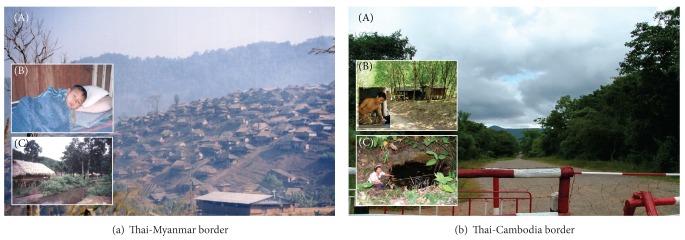Figure 1.

Complex epidemiological settings of border malaria. (a) A hilly 2202 km long Thai-Myanmar border where most investigations center on epidemiology, surveillance, and monitoring of MDR-associated BM in Tak province, Thailand, as one important area of studying MDR malaria in Southeast Asia region. (A) Numerous refugees revisiting either refugee camps temporarily or nearby pocket villages outside camps play important role in malaria transmission. (B) Schoolchildren including 12-year-old boy infected with P. vivax are at risk of malaria infections in endemic villages. (C) Breeding site of potent malaria vector, Anopheles minimus, is commonly found in endemic villages with irrigation and agricultural practices. (b) Similar to the endemic settings on or surrounding Thai-Myanmar border, a 798 km long Thai-Cambodia border where human settlements have extended to pocket villages with agricultural intensifications on plantations of rubber trees and fruit orchards. (A) Border crossings at immigration checkpoints are easier for migration of cross-border people due to geographical uplands, hills, hillside slope areas, and valleys. (B) Myanmar migrant workers including 32-year-old rubber plantation worker infected with P. vivax are at risk of malaria infections in endemic villages; both Myanmar and Cambodian migrant workers play key role in border malaria transmission. (C) Breeding site of potent Anopheles dirus and Anopheles maculatus is commonly close to human inhabitations with fruit orchards or rubber plantations.
